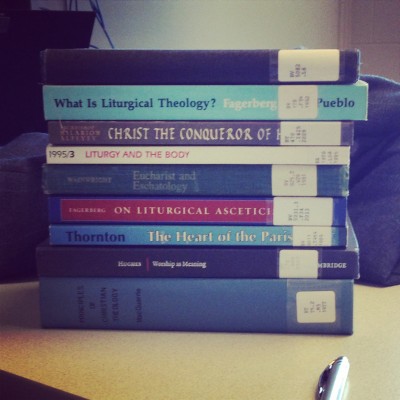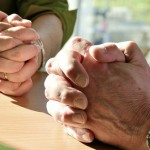Sermon Notes – Easter 2 – Year B
“My Lord and my God!”
Thesis
We are concluding Bright Week with the words of St. Thomas when he proclaimed, “My Lord and my God!” These words are significant to believers, but why? What does it mean for Jesus to be Lord and God? My hunch for this week’s sermon is that the lessons flesh out what it means when Jesus is understood as Lord and God. Give people Jesus this week!
Analysis
Collect
“Show forth in their lives what they profess by their faith.” The Collect launches us into radical discipleship very quickly. Our walk needs to match our talk (don’t you just hate that phrase?!). Or, to put it in the vernacular, we need to be “smoking what we’re selling.” I don’t mean to be crass, but that is a good image. Are we really living out in the here and now what we claim to believe on a Sunday morning? Do our lives match that which we proclaim in the Creed, the prayers of the people or the Eucharist?
Our faith is based on the Paschal Mystery. That is, our faith is based on the combination of Cross and Empty Tomb. I heard N. T. Wright put it this way in a lecture last year, “The resurrection of the Crucified One gives meaning to the crucifixion of the Resurrected One.” Our faith is based on the intersection of this two events; no, it is actually the interweaving of these two events into a holistic whole.
Because Jesus is both crucified and risen can we profess and show forth as agents of reconciliation.
First Lesson – Acts 4:32-35
We’ve gotten a bit ahead of ourselves in this lesson. It’s important to bear in mind that between Easter Sunday and Acts 4 is Pentecost and the giving of the Holy Spirit to the church. Acts 4:32-35 makes little sense without the empowering ministry of the Spirit.
The young, little church is growing daily. What sets the church apart from competing narratives and groups is her common lifestyle. (The Resurrection of the Son of God also sets the church apart…!) Acts 4:32-35 is a dynamic picture of the church fulfilling that which her Lord called her to on Maundy Thursday: love one another, and they will know you by your love. The church was in the business of caring for one another and for those around them.
At the center of this life of overflowing love was the apostle’s testimony to the resurrection of Jesus. Without the resurrection these actions would simply be like welfare, or a non-profit organization, or any other modern group that does “good” for others. No, these actions only gain meaning because they stem forth from the Risen One. A church that has faith without actions is dead, but a church that has works without faith isn’t a church at all.
Psalm 133
The concept of fellowship is continued in the selection from the Psalter. Psalm 133 is one of the Psalms of Ascent; indeed it is the second to last Psalm of Ascent and was part of the crescendo of liturgical proclamation for Israel as she sojourned to Jerusalem three times a year for festivals. This is both a present aspiration and eschatological image. Fellowship such as this, true koinonia, is possible in the here and now through the power of the Holy Spirit. However, this fellowship will only fully and eternally be known when God is all and all and we are praising and reigning with the triune God. May we strive toward such unity in our churches and in the Church, and may we know that this side of eternity we will only see as through a glass dimly lit.
Epistle – 1 John 1:1-2:2
1 John continues the trend of fellowship and the call to discipleship. Before we can unpack the message of 1 John 1:1-2:2 we need to understand who is writing. John is writing and he is doing so in harmony with others who have experienced the Paschal Mystery with the five senses. Paul may have been a Jew of Jews, but John and the disciples could boast something greater: they heard the voice of Jesus for three years, they tasted the bread and wine offered by the Lord, they smelled the fragrant oil that Mary used to anoint Jesus’ feet, they saw his tears as he wept over his friend Lazarus, they saw him hanging on the cross; they touched the scars on this hands and wound on his side. In short, the true Apostles of the church are able to claim authority of teaching because they received it firsthand from the Lord himself. You’ll notice that Paul claims the same authority in 1 Corinthians and elsewhere; they all claim that they are passing along what they have received (paralambano) because they can trace it to the source. That’s John’s point: trust me, I know what I’m talking about because I know from whom I received this.
For God is light and in him there is no darkness. Fellowship is first and foremost with the Father and the Son (and the Holy Spirit). It is out of the overflow of koinonia amongst the Trinity that human koinonia has substance. Again, a church that has unity within itself but is not unified with the Godhead is not a church at all.
We lie against the light if we claim to be the light and/or if we have darkness. Sin has no place in the Christian life. That does not mean that we are sinless. Far from it! We are still sinful but we are no longer slavers to sin because Jesus is our Advocate. We have been changed from sinners to saints but we still sin regularly. But what would it look like if our sins were truly upsetting to us? In the early church there was a belief that postbaptismal sin was unacceptable and that you could be absolved only once for sin after baptism. I’m not suggest this to be true in the least, but think about the severity with which they viewed sin. Does our sin grieve us? Do we strive toward holiness or would we rather toe the line of sinfulness without actually touching it? I want light! I want holiness!
Therefore, our fellowship with each other is made real because we have been cleansed by the blood of our Advocate. We can have right relationship with each other only because of the right relationship we’ve been given through and by and with Jesus. Fellowship is a call to discipleship. Again, our actions and our words need to match up.
Gospel – John 20:19-31
The Gospel lesson picks up right where we left off last week: we’re still on Easter Sunday. Mary has just run from the Garden to the disciples and announced, “I have seen the Lord.”
The disciples are still gathered together (expect Thomas and Judas) and Jesus appears. What does he speak to them? He speaks peace. He is peace. He breathes his Holy Spirit over them. Just as YHWH breathed life into humanity (ruach) in Genesis 2, so too does Jesus give new life to his followers. And this new life is empowering. The Holy Spirit gives them the ability to forgive sins, to lose and to bind. To receive the Holy Spirit and the true shalom of God is to be commissioned for ministry.
Thomas isn’t present. We don’t know where Thomas was but we do know that he had doubts. Friends, doubts are ok! Thomas isn’t rebuked for his doubts by his brothers or our Lord. Thomas isn’t told to suck it up and believe because questions or the need for proof is wrong. No! Thomas is given the opportunity by our Lord to touch his wounds and to worship. Thomas worships on the spot with his proclamation: My Lord and my God. In touching the Lord’s hands and side, Thomas knew that he was encountering the crucified and risen Lord. He know that Jesus wasn’t appearing as some sort of ghost or aberration but in the flesh, in the present, in reality. That is the God we worship. That is the Lord of all creation. But are you worshipping him? Jesus is a big boy, he can handle your feelings of doubt, but when you encounter the risen Lord what is your response?
Liturgical Considerations
The Second Sunday of Easter (the Sunday of Thomas) is the conclusion of Easter Week (Anglican and Catholic) or Bright Week (Orthodox). In the patristic church, and still in the Orthodox Church, Bright Week was a weeklong celebration for the newly baptized. Indeed those who had been baptized on Easter were to wear their white garments for the entirety of Bright Week. During Bright Week the newly baptized went through mystagogy; that is, they were instructed in the Holy Mysteries of the Church and were therefore illuminated (i.e. made bright).
Such a historical reality could factor into your sermon this week because at the end of Bright Week shouldn’t we all be able to properly proclaim, “My Lord and my God” like St. Thomas? What would it look like for you to offer some real catechesis and instruction during Bright Week, or at least to have your people reaffirm their baptismal covenant if you didn’t do this via Easter Vigil? To be discipled is to grow in wisdom, stature, understanding and most importantly: more and more into the likeness of Christ. Inviting people into the mysteries of the church—both through participation and instruction—is a form of spiritual formation and liturgical catechesis.
Synthesis
If you haven’t noticed it already, one of my favorite approaches for sermons is to use phrases from the lessons as points in my “So what” section at the end. These lessons are no exception. I’m not going to put the meat on these points because I’d rather you receive inspiration from the Spirit and use some sanctified imagination as you know your context better than I do. Here they are:
- “We have seen the Lord.”
- “Show forth in their lives what they profess by faith.”
- “Peace be with you.”
- “My Lord and my God!”
Remember, this is the conclusion of Bright Week and the Sunday of Thomas has been part of the liturgical calendar of the church for many hundreds of years: do something about it. His words are offered to Jesus as reverent worship; may we worship at the Lord’s feet like Thomas. May we see the Lord and profess him with lips and lives. May we offer the world the shalom of God.











